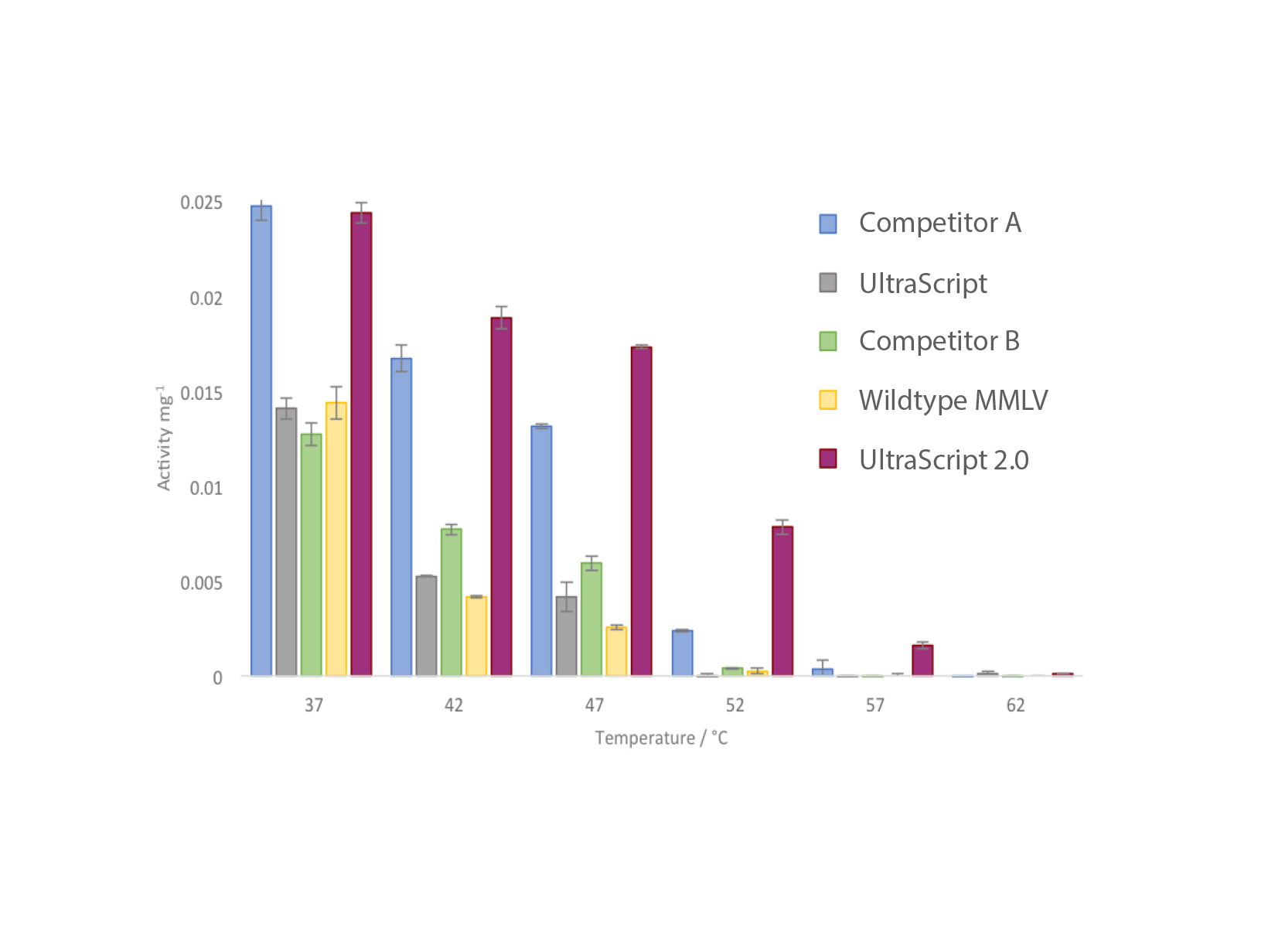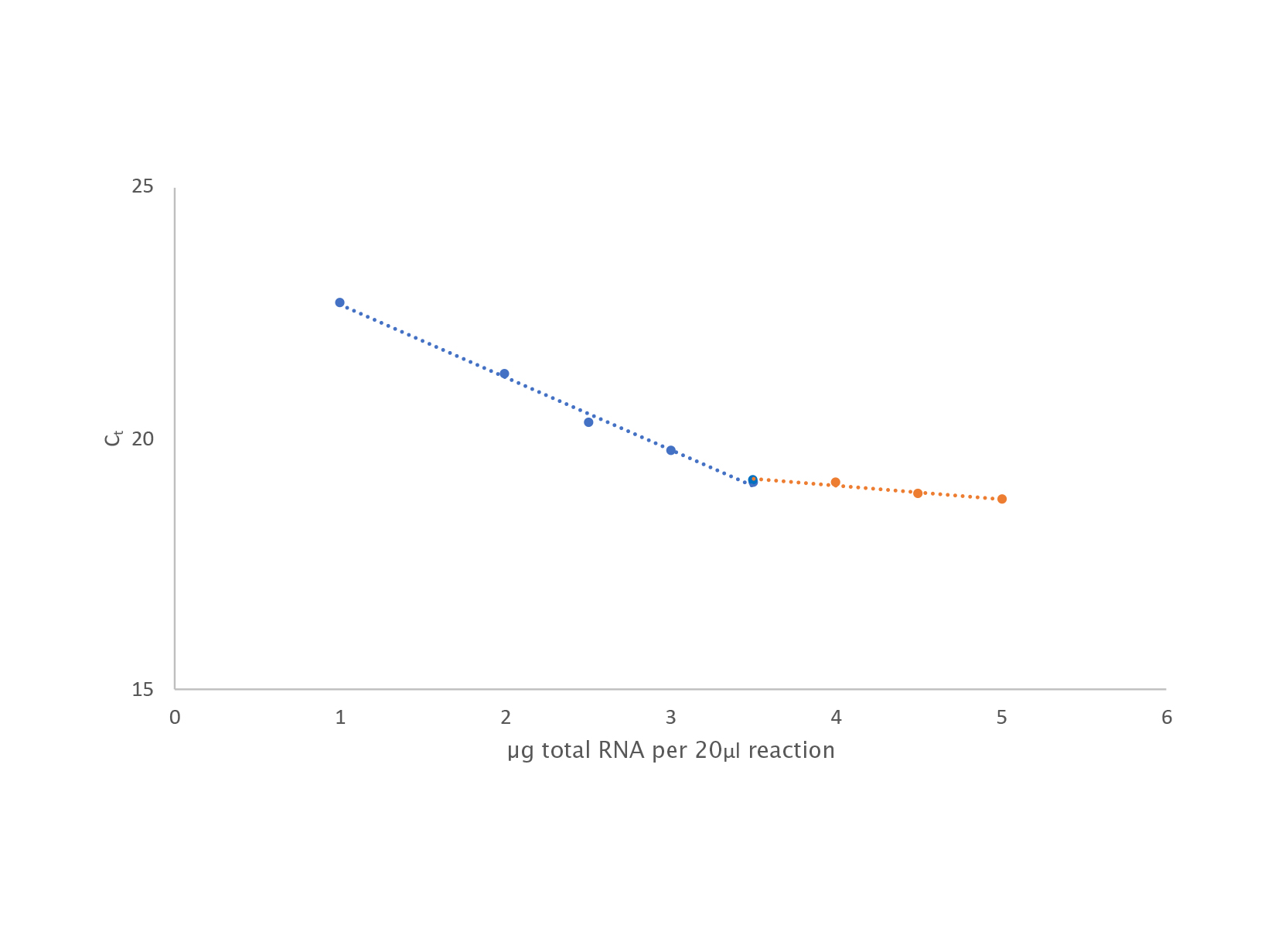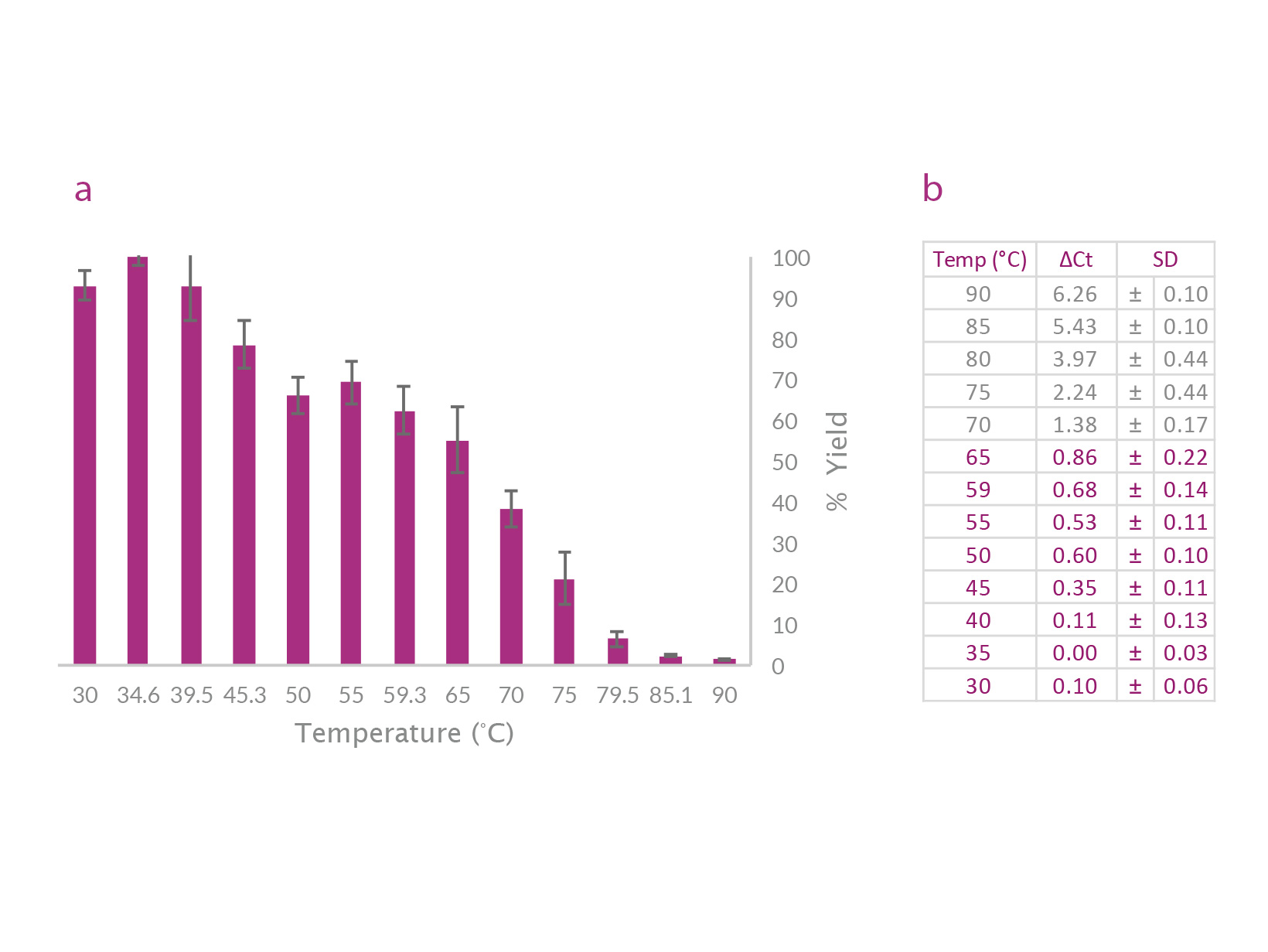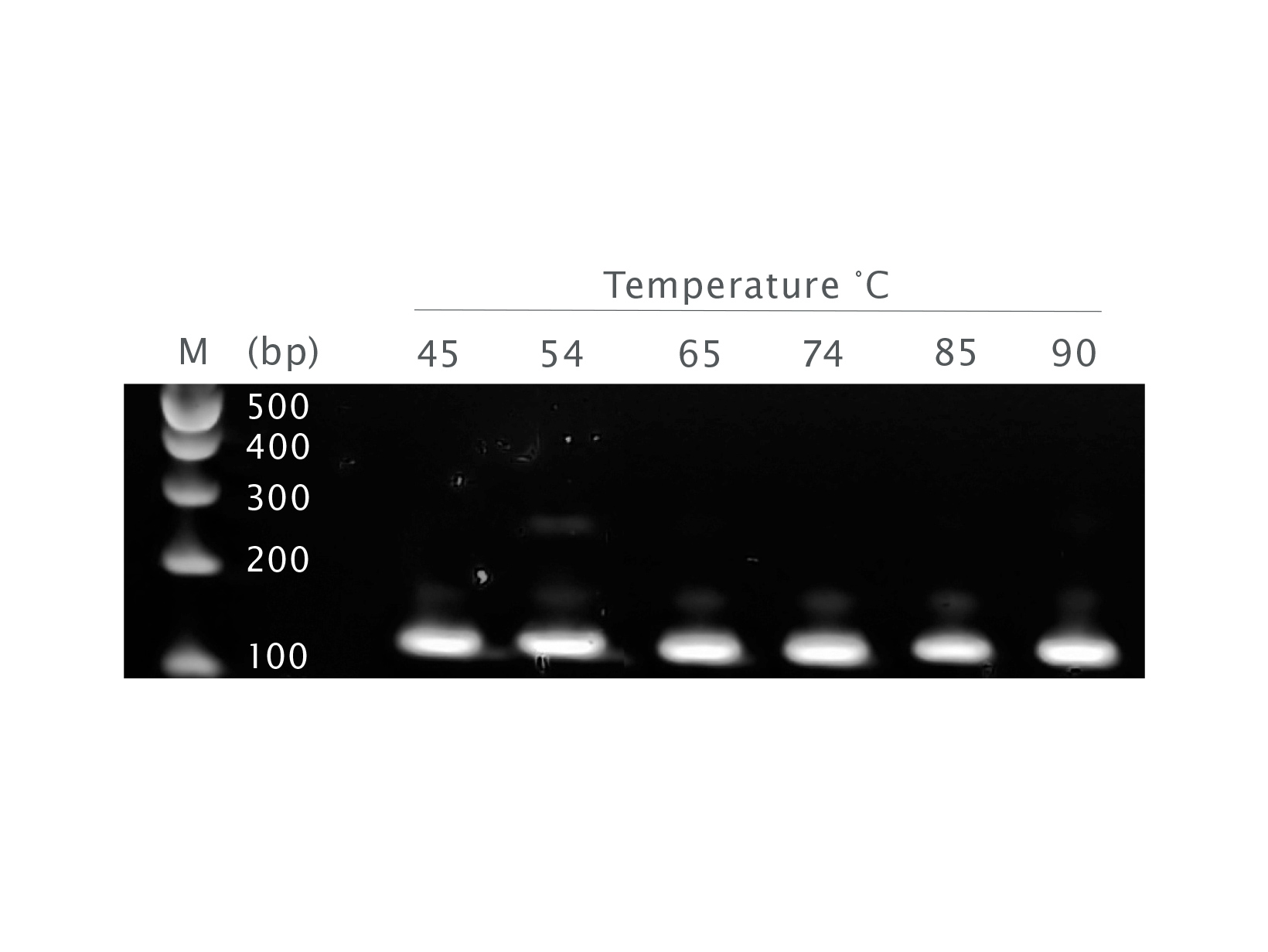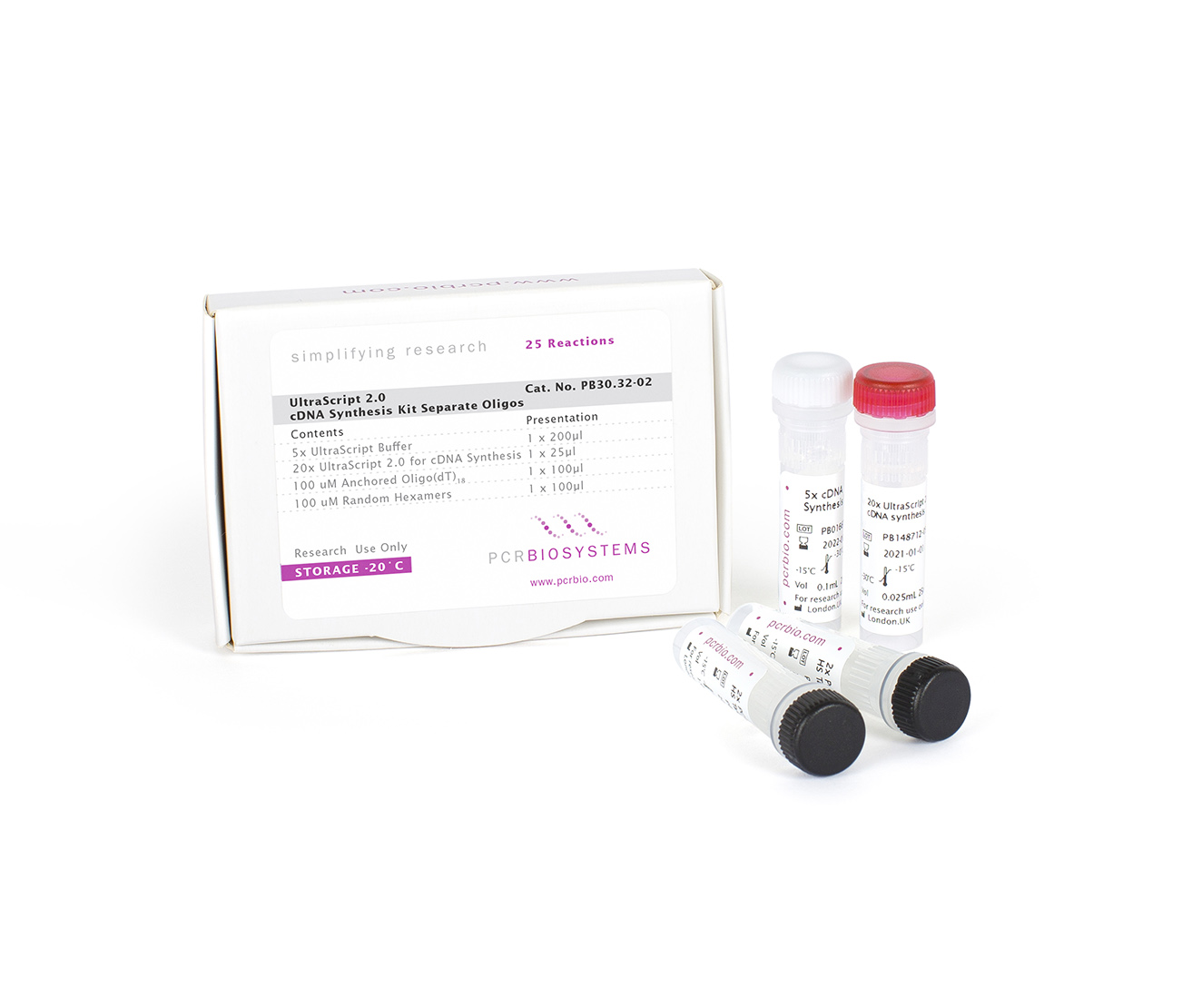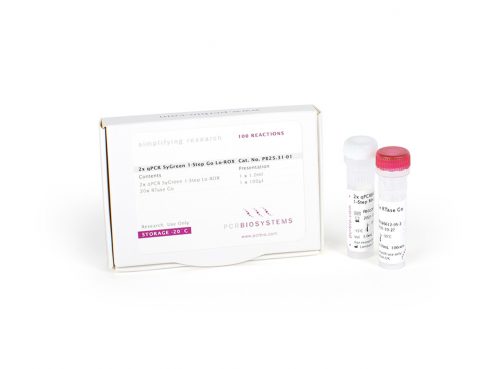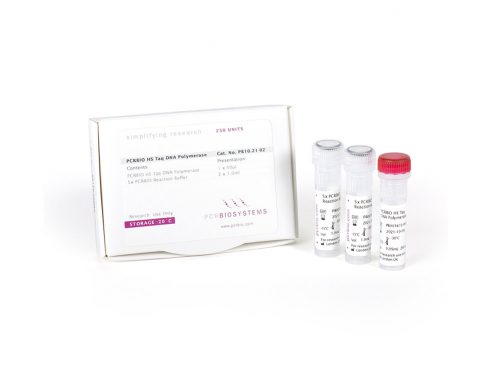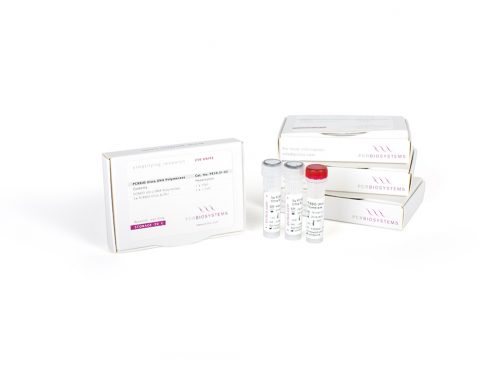To view your price please login or contact us
UltraScript 2.0 Reverse Transcriptase & Kits
UltraScript 2.0 Reverse Transcriptase is a highly thermostable reverse transcriptase engineered for superior cDNA synthesis speed, yield and representation of the most challenging RNA sample types.
This modified MMLV reverse transcriptase can be used with reaction temperatures of over 55°C, giving improved specificity, higher cDNA yields and more full length cDNA product.
Features
- Highly thermostable reverse transcriptase 55°C to 65°C and above
- Advanced RNase inhibitor
- High cDNA yields from as little as 20pg total RNA
- Accurate reverse transcription of GC-rich and highly structured transcripts
- High sensitivity for challenging templates
- Reduced RNase H activity
- Available as a stand-alone enzyme with buffer, a cDNA synthesis kit with premixed oligos and a cDNA synthesis kit with separate oligos
More Information
The enhanced thermostability of UltraScript 2.0 Reverse Transcriptase (RTase) allows reaction temperatures of over 55°C to be used, giving improved specificity, higher cDNA yields, and more full length cDNA product. The enzyme remains partially active even up to 90°C and is designed for efficient reverse transcription of the most difficult RNA templates, including GC-rich and highly structured transcripts.
UltraScript 2.0 RTase is designed for efficient cDNA synthesis from a broad range of RNA concentrations. UltraScript 2.0 kits can be used with 20pg to 3.5μg total RNA or oligo(dT) purified mRNA. The RTase is blended with an advanced RNase inhibitor preventing degradation of RNA by contaminating RNase.
UltraScript 2.0 RTase is available in three convenient formats, each with dNTPs, MgCl2, and RNase inhibitor included. Our stand-alone enzyme with 5x buffer gives users the flexibility to define their own priming strategy and offers exceptional performance with gene-specific primers, oligo(dT) and random hexamers.
The 2-tube UltraScript 2.0 cDNA Synthesis Kit contains all the components required for fast, reliable and unbiased cDNA synthesis, including an optimised blend of anchored oligo(dT) and random hexamers. UltraScript 2.0 cDNA Synthesis Kit Separate Oligos provides anchored oligo(dT) and random hexamers in separate tubes, for user optimisation depending on the type of analysis needed.
Applications
- cDNA synthesis for PCR analysis, cloning, cDNA library preparation and Next Generation Sequencing
- Viral RNA targets
- miRNA targets
- Efficient synthesis from total RNA or poly(A)+ RNA
Specifications
UltraScript 2.0 Reverse Transcriptase
Component
10,000 Units
40,000 Units
UltraScript 2.0 (200u/μL) with RNase Inhibitor
2 x 25μL
2 x 100μL
5x UltraScript Buffer
1 x 200μL
4 x 200μL
UltraScript 2.0 cDNA Synthesis Kit
Component
25 Reactions
100 Reactions
20x UltraScript 2.0 for cDNA Synthesis with RNase Inhibitor
1 x 25μL
1 x 100μL
5x cDNA Synthesis Mix
1 x 100μL
4 x 100μL
UltraScript 2.0 cDNA Synthesis Kit Separate Oligos
Component
25 Reactions
100 Reactions
20x UltraScript 2.0 for cDNA Synthesis with RNase Inhibitor
1 x 25μL
1 x 100μL
5x UltraScript Buffer
1 x 200μL
2 x 200μL
100μM Anchored Oligo(dT)18
1 x 100μL
1 x 100μL
100μM Random Hexamers
1 x 100μL
1 x 100μL
UltraScript 2.0 Reverse Transcriptase
Component
UltraScript 2.0 (200u/μL) with RNase Inhibitor
5x UltraScript Buffer
10,000 Units
2 x 25μL
1 x 200μL
40,000 Units
2 x 100μL
4 x 200μL
UltraScript 2.0 cDNA Synthesis Kit
Component
20x UltraScript 2.0 for cDNA Synthesis with RNase Inhibitor
5x cDNA Synthesis Mix
25 Reactions
1 x 25μL
1 x 100μL
100 Reactions
1 x 100μL
4 x 100μL
UltraScript 2.0 cDNA Synthesis Kit Separate Oligos
Component
20x UltraScript 2.0 for cDNA Synthesis with RNase Inhibitor
5x UltraScript Buffer
100μM Anchored Oligo(dT)18
100μM Random Hexamers
25 Reactions
1 x 25μL
1 x 200μL
1 x 100μL
1 x 100μL
100 Reactions
1 x 100μL
2 x 200μL
1 x 100μL
1 x 100μL
Reaction Volume
Storage
20μL
On arrival, products should be stored between -30 and -15°C. If stored correctly the kit will retain full activity for 12 months.
Reaction Volume
20μL
Storage
On arrival, products should be stored between -30 and -15°C. If stored correctly the kit will retain full activity for 12 months.
Documents
Product Flyers
Product Manuals
Material Safety Data Sheets
Certificate of Analysis Finder
FAQs
Can long targets (15-20 kb) be reverse transcribed by UltraScript 2.0 RTase?
20 kb RNA reverse transcription can be achieved with all our RTases because RTases jump on and off their primed substrates. Secondary structures, unspecific binding and mis-priming can be the most common causes for the reaction ending prematurely.
We advise using specific primers or oligo(dT) and optimising each aspect of the reaction, for example, the different enzyme concentrations, primers, primer concentration, temperature and temperature cycling and time. Also, the subsequent PCR/qPCR step might need optimisation.
We recommend UltraScript 2.0 RTase for reverse transcribing long templates because it can sustain higher temperatures for longer, which may be necessary as the probability of secondary structures in RNA increases with its length.
We’ve included the following paper for your reference1.
1 Thiel, V. et al. Effective amplification of 20-kb DNA by reverse transcription PCR. Anal Biochem 252, 62-70, doi:10.1006/abio.1997.2307 (1997).
Can miRNA be amplified using UltraScript 2.0 Reverse Transcriptase?
All our RTases are can be used for miRNA quantification and analysis. However, we do not sell any dedicated kits.
We advise that you use one of the two following approaches:
- Use universal RT primers and add poly(A) or poly(U) tails (e.g. by poly(U)-polymerase), followed by cDNA synthesis using universal primers1,2.
- Use specific RT primers and omit the tailing step1,3-5.
If you are unfamiliar with the specifics of those approaches, please refer to the reference list below, which serve as a guideline.
1 Dave, V. P. et al. MicroRNA amplification and detection technologies: opportunities and challenges for point of care diagnostics. Lab Invest 99, 452-469, doi:10.1038/s41374-018-0143-3 (2019).
2 Mei, Q. et al. A facile and specific assay for quantifying microRNA by an optimized RT-qPCR approach. PLoS One 7, e46890, doi:10.1371/journal.pone.0046890 (2012).
3 Chen, C. et al. Real-time quantification of microRNAs by stem-loop RT-PCR. Nucleic Acids Res 33, e179, doi:10.1093/nar/gni178 (2005).
4 Raymond, C. K., Roberts, B. S., Garrett-Engele, P., Lim, L. P. & Johnson, J. M. Simple, quantitative primer-extension PCR assay for direct monitoring of microRNAs and short-interfering RNAs. RNA 11, 1737-1744, doi:10.1261/rna.2148705 (2005).
5 Androvic, P., Valihrach, L., Elling, J., Sjoback, R. & Kubista, M. Two-tailed RT-qPCR: a novel method for highly accurate miRNA quantification. Nucleic Acids Res 45, e144, doi:10.1093/nar/gkx588 (2017).
Can UltraScript 2.0 be used with blood or plasma samples?
UltraScript 2.0 has an excellent ability to handle various RT inhibitors including those found in blood and plasma. We recommend optimisation by performing a titration of the amount blood/plasma sample for RT reaction, varying the amount enzyme and diluting cDNA product. Refer to “How can high Ct’s in the qPCR step or low PCR product on the gel after a RT step (PCR/qPCR problem) be alleviated?” for further fine tuning of the protocol.
Can UltraScript 2.0 Reverse Transcriptase do template switching?
All our RTases can be used in template switching applications. We currently do not provide a full protocol or dedicated kit but we recommend referring to this list of articles for reference1-4.
1 Takada, S. & Mano, H. Profiling of microRNA expression by mRAP. Nat Protoc 2, 3136-3145, doi:10.1038/nprot.2007.457 (2007).
2 Picelli, S. et al. Full-length RNA-seq from single cells using Smart-seq2. Nat Protoc 9, 171-181, doi:10.1038/nprot.2014.006 (2014).
3 Moldovan, N. et al. Multi-Platform Sequencing Approach Reveals a Novel Transcriptome Profile in Pseudorabies Virus. Front Microbiol 8, 2708, doi:10.3389/fmicb.2017.02708 (2017).
4 Zajac, P., Islam, S., Hochgerner, H., Lonnerberg, P. & Linnarsson, S. Base preferences in non-templated nucleotide incorporation by MMLV-derived reverse transcriptases. PLoS One 8, e85270, doi:10.1371/journal.pone.0085270 (2013).
How can high Ct’s in the qPCR step or low PCR product on the gel after a RT step (PCR/qPCR problem) be alleviated?
Perform gel electrophoresis to verify the amount of cDNA product. If the amount of cDNA product after the RT step is not sufficient, there might be a problem with RTase inhibiting Taq1. Try solving this by diluting the cDNA product 10-20x before adding 2.5 μL of this diluted reaction to 20 μL of total reaction volume. Adjust accordingly if the volumes are different. Alternatively, try diluting the enzyme itself before the RT step by carrying out 5x, 10x, 20x and 40x dilutions. These two procedures can also be combined in case further fine tuning is required to find the optimal result.
1 Suslov, O. & Steindler, D. A. PCR inhibition by reverse transcriptase leads to an overestimation of amplification efficiency. Nucleic Acids Res 33, e181, doi:10.1093/nar/gni176 (2005).
The cDNA yield is low. What can I do to help?
We advise you first ensure that cDNA yield is low rather than downstream PCR/qPCR yield or Cts are unsatisfactory. If the latter is the case, refer to “How can high Ct’s in the qPCR step or low PCR product on the gel after a RT step (PCR/qPCR problem) be alleviated?”. If the former is the case, there could be multiple reasons for low yield occurring when using UltraScript 2.0.:
- The amount or the integrity of your RNA could be insufficient to reach a significant amount of product required for the subsequent endpoint or qPCR step. Try increasing the amount RNA and/or check the quality of your RNA using gel electrophoresis and RIN value. Consider an alternative purification protocol for your RNA and/or use RNase inhibitor early on. All our RTases contain RNase inhibitor but for some applications it might be necessary to add it before RT step
- You RNA prep may contain inhibitors such as haem, high concentrations of NaCl, SDS, guanidine thiocyanate, melanin, or calcium1. Try an alternative method of purification that gets rid of all substances that can inhibit reaction. You could also try diluting your RNA before the reaction. This will decrease the theoretical yield, but it will also dilute inhibitors to levels more permissible for the RTase to work efficiently. This could still provide enough product for subsequent steps.
- Some RNAs are inherently difficult to transcribe due to secondary structures and/or stretches of sequences that are not an ideal substrate for RTase. Try increasing the temperature and/or performing RNA denaturation/primer annealing, at 70°C for 10 minutes, before adding RTase.
- Using RNAseH treatment after RT step can increase the yield, especially for GC rich targets because RNA-DNA heteroduplexes are more stable than DNA-DNA duplexes.
- If your sequences are still underrepresented it might be necessary to use a more targeted approach with specific primers or just oligo(dT)s. We recommend UltraScript Reverse Transcriptase or UltraScript 2.0 Reverse Transcriptase that come with a buffer without any hexamers and oligo(dT)s for that purpose.
1 Schrader, C., Schielke, A., Ellerbroek, L. & Johne, R. PCR inhibitors – occurrence, properties and removal. J Appl Microbiol 113, 1014-1026, doi:10.1111/j.1365-2672.2012.05384.x (2012).
What are the main differences between UltraScript and UltraScript 2.0 Reverse Transcriptases?
Both products are derived from wild-type MMLV reverse transcriptase and contain multiple mutations that enhance their function. They are each excellent RTases in their own right. UltraScript 2.0 is more thermostable up to 65°C and above, resistant to inhibitors and capable of reverse transcribing large quantities of RNA up to 3.5 μg. UltraScript 2.0 can be also used for applications requiring sensitivity due to a low amount of RNA present, however, this requires substantial optimisation on the users side using the current formulation and we recommend using UltraScript instead. UltraScript can be used with 1-step kits whereas UltraScript 2.0 should be used only as a part of the 2-step process (RT then PCR). UltraScript 2.0 is especially recommended for long and difficult templates that contain large amounts secondary structure. Both RTases can be used with cDNA synthesis kit with/or without hexamers and oligo-d(T).
What are the recommendations for diluting UltraScript 2.0 to avoid RTase-induced Taq inhibition?
- Diluting UltraScript 2.0 prior reverse transcription.
- Assuming 2.5 µL of RTase reaction is transferred to 20 µL of PCR reaction (4x dilution)
- We recommend diluting the RTase 10x – 50x to nullify the effects of RTase-induced Taq inhibition.
- We recommend the following buffer or equivalent for the dilutions:
- 20 mM Tris/Cl pH 8.0 (25°C)
- 100 mM KCl
- 1 mM EDTA
- 1 mM DTT
- 5 % (w/v) Tween 20
- 5% (w/v) Triton X-100
- 50% (v/v) Glycerol
- Diluting UltraScript 2.0 after reverse transcription, that is, diluting the reaction mixture
- Diluting the RT reaction mixture dilutes out the inhibitory effect of the RTase as well as cDNA therefore we recommend dilutions between 5x – 15x to find the optimal result.
- Assuming 2.5 µL of RTase reaction is transferred to 20 µL of PCR/qPCR reaction, 4x dilution for a total of 20x – 60 x. Use water for RT reaction dilutions.
What is the dynamic range of UltraScript™ 2.0?
Overall UltraScript™ 2.0 can reverse transcribe as little as 20 pg and up to 3.5 μg of RNA. The performance depends on the type of RNA, RNA quality and whether specific primers, oligod(T)s or random hexamers are used. If you’re working with RNA quantities between 5 ng and 3.5 μg, it is best to use undiluted UltraScript™ 2.0. For applications requiring access to a more sensitive performance of UltraScript™ 2.0, diluting the enzyme and cDNA product might be necessary. Please refer to “How can high Ct’s in the qPCR step or low PCR product on the gel after a RT step (PCR/qPCR problem) be alleviated?”. Keep in mind that when using enzyme that is more diluted, one will compromise its performance at high capacity RNA input but improve sensitivity since those two are offset by each other.
What is the error rate of UltraScript 2.0 Reverse Transcriptase?
Like the great majority of the RTases available on the market UltraScript Reverse Transcriptase, as well as all other RTases we offer, are derived from wild-type Moloney Murine Leukemia Virus (MMLV) RTase and have an error rate of 1×10-4 errors/bp1. This also applies to RTases derived from Avian Myeloblastosis Virus (AMV).
Running the reaction at a higher temperature increases fidelity because it destabilises mismatched base pairs2. If low fidelity is required adding manganese will make RTases highly mutagenic and could increase their speed3.
1 Yasukawa, K. et al. Next-generation sequencing-based analysis of reverse transcriptase fidelity. Biochem Biophys Res Commun 492, 147-153, doi:10.1016/j.bbrc.2017.07.169 (2017).
2 Malboeuf, C. M., Isaacs, S. J., Tran, N. H. & Kim, B. Thermal effects on reverse transcription: improvement of accuracy and processivity in cDNA synthesis. Biotechniques 30, 1074-1078, 1080, 1082, passim, doi:10.2144/01305rr06 (2001).
3 Cadwell, R. C. & Joyce, G. F. Randomization of genes by PCR mutagenesis. PCR Methods Appl 2, 28-33 (1992).
What troubleshooting is there if smears or non-specific products are visible after using UltraScript™ 2.0 RTase?
There could be multiple reasons for the appearance of smears or non-specific products after the RT reaction. The following points can be considered for troubleshooting:
- It’s important to establish if the problem relates to the reverse transcription step or PCR/qPCR step, provided the PCR/qPCR step is performed downstream from the reverse transcription step. Use proper controls and troubleshoot the PCR/qPCR reaction to exclude this from the list of potential steps causing the above problems.
- Smearing can indicate primer oligomerisation. Oligomerisation can be caused if the oligomers are badly designed and if the template concentration is low. This will result in reverse transcription of primer-dimers or off-target sequences. We advise redesigning primers, increasing reaction temperature, increasing the amount of template, decreasing primer concentration or shortening the reaction time. These considerations can also be used for non-specific bands.
- Primers may not be specific to your target sequence and may require redesign.
- Primers against highly repetitive sequences can cause smearing and redesigning your primers may have to be considered.
- Your RNA may be degraded. Try increasing the amount of RNA and/or check the quality of your RNA using gel electrophoresis and RIN value. Try an alternative purification protocol for your RNA and/or use RNase inhibitor early on. All our RTases contain RNA inhibitor but for some applications it might be necessary to add it before the RT step.
- Consider the standard precautions when handling RNA such as using gloves, positive displacement pipettes with aerosol barrier, etc.
- Ensure there is no DNA contamination.
More Information
The enhanced thermostability of UltraScript 2.0 Reverse Transcriptase (RTase) allows reaction temperatures of over 55°C to be used, giving improved specificity, higher cDNA yields, and more full length cDNA product. The enzyme remains partially active even up to 90°C and is designed for efficient reverse transcription of the most difficult RNA templates, including GC-rich and highly structured transcripts.
UltraScript 2.0 RTase is designed for efficient cDNA synthesis from a broad range of RNA concentrations. UltraScript 2.0 kits can be used with 20pg to 3.5μg total RNA or oligo(dT) purified mRNA. The RTase is blended with an advanced RNase inhibitor preventing degradation of RNA by contaminating RNase.
UltraScript 2.0 RTase is available in three convenient formats, each with dNTPs, MgCl2, and RNase inhibitor included. Our stand-alone enzyme with 5x buffer gives users the flexibility to define their own priming strategy and offers exceptional performance with gene-specific primers, oligo(dT) and random hexamers.
The 2-tube UltraScript 2.0 cDNA Synthesis Kit contains all the components required for fast, reliable and unbiased cDNA synthesis, including an optimised blend of anchored oligo(dT) and random hexamers. UltraScript 2.0 cDNA Synthesis Kit Separate Oligos provides anchored oligo(dT) and random hexamers in separate tubes, for user optimisation depending on the type of analysis needed.
Applications
- cDNA synthesis for PCR analysis, cloning, cDNA library preparation and Next Generation Sequencing
- Viral RNA targets
- miRNA targets
- Efficient synthesis from total RNA or poly(A)+ RNA
Specifications
UltraScript 2.0 Reverse Transcriptase
Component
10,000 Units
40,000 Units
UltraScript 2.0 (200u/μL) with RNase Inhibitor
2 x 25μL
2 x 100μL
5x UltraScript Buffer
1 x 200μL
4 x 200μL
UltraScript 2.0 cDNA Synthesis Kit
Component
25 Reactions
100 Reactions
20x UltraScript 2.0 for cDNA Synthesis with RNase Inhibitor
1 x 25μL
1 x 100μL
5x cDNA Synthesis Mix
1 x 100μL
4 x 100μL
UltraScript 2.0 cDNA Synthesis Kit Separate Oligos
Component
25 Reactions
100 Reactions
20x UltraScript 2.0 for cDNA Synthesis with RNase Inhibitor
1 x 25μL
1 x 100μL
5x UltraScript Buffer
1 x 200μL
2 x 200μL
100μM Anchored Oligo(dT)18
1 x 100μL
1 x 100μL
100μM Random Hexamers
1 x 100μL
1 x 100μL
UltraScript 2.0 Reverse Transcriptase
Component
UltraScript 2.0 (200u/μL) with RNase Inhibitor
5x UltraScript Buffer
10,000 Units
2 x 25μL
1 x 200μL
40,000 Units
2 x 100μL
4 x 200μL
UltraScript 2.0 cDNA Synthesis Kit
Component
20x UltraScript 2.0 for cDNA Synthesis with RNase Inhibitor
5x cDNA Synthesis Mix
25 Reactions
1 x 25μL
1 x 100μL
100 Reactions
1 x 100μL
4 x 100μL
UltraScript 2.0 cDNA Synthesis Kit Separate Oligos
Component
20x UltraScript 2.0 for cDNA Synthesis with RNase Inhibitor
5x UltraScript Buffer
100μM Anchored Oligo(dT)18
100μM Random Hexamers
25 Reactions
1 x 25μL
1 x 200μL
1 x 100μL
1 x 100μL
100 Reactions
1 x 100μL
2 x 200μL
1 x 100μL
1 x 100μL
Reaction Volume
Storage
20μL
On arrival, products should be stored between -30 and -15°C. If stored correctly the kit will retain full activity for 12 months.
Reaction Volume
20μL
Storage
On arrival, products should be stored between -30 and -15°C. If stored correctly the kit will retain full activity for 12 months.
Documents
Product Flyers
Product Manuals
Material Safety Data Sheets
Certificate of Analysis Finder
FAQs
Can long targets (15-20 kb) be reverse transcribed by UltraScript 2.0 RTase?
20 kb RNA reverse transcription can be achieved with all our RTases because RTases jump on and off their primed substrates. Secondary structures, unspecific binding and mis-priming can be the most common causes for the reaction ending prematurely.
We advise using specific primers or oligo(dT) and optimising each aspect of the reaction, for example, the different enzyme concentrations, primers, primer concentration, temperature and temperature cycling and time. Also, the subsequent PCR/qPCR step might need optimisation.
We recommend UltraScript 2.0 RTase for reverse transcribing long templates because it can sustain higher temperatures for longer, which may be necessary as the probability of secondary structures in RNA increases with its length.
We’ve included the following paper for your reference1.
1 Thiel, V. et al. Effective amplification of 20-kb DNA by reverse transcription PCR. Anal Biochem 252, 62-70, doi:10.1006/abio.1997.2307 (1997).
Can miRNA be amplified using UltraScript 2.0 Reverse Transcriptase?
All our RTases are can be used for miRNA quantification and analysis. However, we do not sell any dedicated kits.
We advise that you use one of the two following approaches:
- Use universal RT primers and add poly(A) or poly(U) tails (e.g. by poly(U)-polymerase), followed by cDNA synthesis using universal primers1,2.
- Use specific RT primers and omit the tailing step1,3-5.
If you are unfamiliar with the specifics of those approaches, please refer to the reference list below, which serve as a guideline.
1 Dave, V. P. et al. MicroRNA amplification and detection technologies: opportunities and challenges for point of care diagnostics. Lab Invest 99, 452-469, doi:10.1038/s41374-018-0143-3 (2019).
2 Mei, Q. et al. A facile and specific assay for quantifying microRNA by an optimized RT-qPCR approach. PLoS One 7, e46890, doi:10.1371/journal.pone.0046890 (2012).
3 Chen, C. et al. Real-time quantification of microRNAs by stem-loop RT-PCR. Nucleic Acids Res 33, e179, doi:10.1093/nar/gni178 (2005).
4 Raymond, C. K., Roberts, B. S., Garrett-Engele, P., Lim, L. P. & Johnson, J. M. Simple, quantitative primer-extension PCR assay for direct monitoring of microRNAs and short-interfering RNAs. RNA 11, 1737-1744, doi:10.1261/rna.2148705 (2005).
5 Androvic, P., Valihrach, L., Elling, J., Sjoback, R. & Kubista, M. Two-tailed RT-qPCR: a novel method for highly accurate miRNA quantification. Nucleic Acids Res 45, e144, doi:10.1093/nar/gkx588 (2017).
Can UltraScript 2.0 be used with blood or plasma samples?
UltraScript 2.0 has an excellent ability to handle various RT inhibitors including those found in blood and plasma. We recommend optimisation by performing a titration of the amount blood/plasma sample for RT reaction, varying the amount enzyme and diluting cDNA product. Refer to “How can high Ct’s in the qPCR step or low PCR product on the gel after a RT step (PCR/qPCR problem) be alleviated?” for further fine tuning of the protocol.
Can UltraScript 2.0 Reverse Transcriptase do template switching?
All our RTases can be used in template switching applications. We currently do not provide a full protocol or dedicated kit but we recommend referring to this list of articles for reference1-4.
1 Takada, S. & Mano, H. Profiling of microRNA expression by mRAP. Nat Protoc 2, 3136-3145, doi:10.1038/nprot.2007.457 (2007).
2 Picelli, S. et al. Full-length RNA-seq from single cells using Smart-seq2. Nat Protoc 9, 171-181, doi:10.1038/nprot.2014.006 (2014).
3 Moldovan, N. et al. Multi-Platform Sequencing Approach Reveals a Novel Transcriptome Profile in Pseudorabies Virus. Front Microbiol 8, 2708, doi:10.3389/fmicb.2017.02708 (2017).
4 Zajac, P., Islam, S., Hochgerner, H., Lonnerberg, P. & Linnarsson, S. Base preferences in non-templated nucleotide incorporation by MMLV-derived reverse transcriptases. PLoS One 8, e85270, doi:10.1371/journal.pone.0085270 (2013).
How can high Ct’s in the qPCR step or low PCR product on the gel after a RT step (PCR/qPCR problem) be alleviated?
Perform gel electrophoresis to verify the amount of cDNA product. If the amount of cDNA product after the RT step is not sufficient, there might be a problem with RTase inhibiting Taq1. Try solving this by diluting the cDNA product 10-20x before adding 2.5 μL of this diluted reaction to 20 μL of total reaction volume. Adjust accordingly if the volumes are different. Alternatively, try diluting the enzyme itself before the RT step by carrying out 5x, 10x, 20x and 40x dilutions. These two procedures can also be combined in case further fine tuning is required to find the optimal result.
1 Suslov, O. & Steindler, D. A. PCR inhibition by reverse transcriptase leads to an overestimation of amplification efficiency. Nucleic Acids Res 33, e181, doi:10.1093/nar/gni176 (2005).
The cDNA yield is low. What can I do to help?
We advise you first ensure that cDNA yield is low rather than downstream PCR/qPCR yield or Cts are unsatisfactory. If the latter is the case, refer to “How can high Ct’s in the qPCR step or low PCR product on the gel after a RT step (PCR/qPCR problem) be alleviated?”. If the former is the case, there could be multiple reasons for low yield occurring when using UltraScript 2.0.:
- The amount or the integrity of your RNA could be insufficient to reach a significant amount of product required for the subsequent endpoint or qPCR step. Try increasing the amount RNA and/or check the quality of your RNA using gel electrophoresis and RIN value. Consider an alternative purification protocol for your RNA and/or use RNase inhibitor early on. All our RTases contain RNase inhibitor but for some applications it might be necessary to add it before RT step
- You RNA prep may contain inhibitors such as haem, high concentrations of NaCl, SDS, guanidine thiocyanate, melanin, or calcium1. Try an alternative method of purification that gets rid of all substances that can inhibit reaction. You could also try diluting your RNA before the reaction. This will decrease the theoretical yield, but it will also dilute inhibitors to levels more permissible for the RTase to work efficiently. This could still provide enough product for subsequent steps.
- Some RNAs are inherently difficult to transcribe due to secondary structures and/or stretches of sequences that are not an ideal substrate for RTase. Try increasing the temperature and/or performing RNA denaturation/primer annealing, at 70°C for 10 minutes, before adding RTase.
- Using RNAseH treatment after RT step can increase the yield, especially for GC rich targets because RNA-DNA heteroduplexes are more stable than DNA-DNA duplexes.
- If your sequences are still underrepresented it might be necessary to use a more targeted approach with specific primers or just oligo(dT)s. We recommend UltraScript Reverse Transcriptase or UltraScript 2.0 Reverse Transcriptase that come with a buffer without any hexamers and oligo(dT)s for that purpose.
1 Schrader, C., Schielke, A., Ellerbroek, L. & Johne, R. PCR inhibitors – occurrence, properties and removal. J Appl Microbiol 113, 1014-1026, doi:10.1111/j.1365-2672.2012.05384.x (2012).
What are the main differences between UltraScript and UltraScript 2.0 Reverse Transcriptases?
Both products are derived from wild-type MMLV reverse transcriptase and contain multiple mutations that enhance their function. They are each excellent RTases in their own right. UltraScript 2.0 is more thermostable up to 65°C and above, resistant to inhibitors and capable of reverse transcribing large quantities of RNA up to 3.5 μg. UltraScript 2.0 can be also used for applications requiring sensitivity due to a low amount of RNA present, however, this requires substantial optimisation on the users side using the current formulation and we recommend using UltraScript instead. UltraScript can be used with 1-step kits whereas UltraScript 2.0 should be used only as a part of the 2-step process (RT then PCR). UltraScript 2.0 is especially recommended for long and difficult templates that contain large amounts secondary structure. Both RTases can be used with cDNA synthesis kit with/or without hexamers and oligo-d(T).
What are the recommendations for diluting UltraScript 2.0 to avoid RTase-induced Taq inhibition?
- Diluting UltraScript 2.0 prior reverse transcription.
- Assuming 2.5 µL of RTase reaction is transferred to 20 µL of PCR reaction (4x dilution)
- We recommend diluting the RTase 10x – 50x to nullify the effects of RTase-induced Taq inhibition.
- We recommend the following buffer or equivalent for the dilutions:
- 20 mM Tris/Cl pH 8.0 (25°C)
- 100 mM KCl
- 1 mM EDTA
- 1 mM DTT
- 5 % (w/v) Tween 20
- 5% (w/v) Triton X-100
- 50% (v/v) Glycerol
- Diluting UltraScript 2.0 after reverse transcription, that is, diluting the reaction mixture
- Diluting the RT reaction mixture dilutes out the inhibitory effect of the RTase as well as cDNA therefore we recommend dilutions between 5x – 15x to find the optimal result.
- Assuming 2.5 µL of RTase reaction is transferred to 20 µL of PCR/qPCR reaction, 4x dilution for a total of 20x – 60 x. Use water for RT reaction dilutions.
What is the dynamic range of UltraScript™ 2.0?
Overall UltraScript™ 2.0 can reverse transcribe as little as 20 pg and up to 3.5 μg of RNA. The performance depends on the type of RNA, RNA quality and whether specific primers, oligod(T)s or random hexamers are used. If you’re working with RNA quantities between 5 ng and 3.5 μg, it is best to use undiluted UltraScript™ 2.0. For applications requiring access to a more sensitive performance of UltraScript™ 2.0, diluting the enzyme and cDNA product might be necessary. Please refer to “How can high Ct’s in the qPCR step or low PCR product on the gel after a RT step (PCR/qPCR problem) be alleviated?”. Keep in mind that when using enzyme that is more diluted, one will compromise its performance at high capacity RNA input but improve sensitivity since those two are offset by each other.
What is the error rate of UltraScript 2.0 Reverse Transcriptase?
Like the great majority of the RTases available on the market UltraScript Reverse Transcriptase, as well as all other RTases we offer, are derived from wild-type Moloney Murine Leukemia Virus (MMLV) RTase and have an error rate of 1×10-4 errors/bp1. This also applies to RTases derived from Avian Myeloblastosis Virus (AMV).
Running the reaction at a higher temperature increases fidelity because it destabilises mismatched base pairs2. If low fidelity is required adding manganese will make RTases highly mutagenic and could increase their speed3.
1 Yasukawa, K. et al. Next-generation sequencing-based analysis of reverse transcriptase fidelity. Biochem Biophys Res Commun 492, 147-153, doi:10.1016/j.bbrc.2017.07.169 (2017).
2 Malboeuf, C. M., Isaacs, S. J., Tran, N. H. & Kim, B. Thermal effects on reverse transcription: improvement of accuracy and processivity in cDNA synthesis. Biotechniques 30, 1074-1078, 1080, 1082, passim, doi:10.2144/01305rr06 (2001).
3 Cadwell, R. C. & Joyce, G. F. Randomization of genes by PCR mutagenesis. PCR Methods Appl 2, 28-33 (1992).
What troubleshooting is there if smears or non-specific products are visible after using UltraScript™ 2.0 RTase?
There could be multiple reasons for the appearance of smears or non-specific products after the RT reaction. The following points can be considered for troubleshooting:
- It’s important to establish if the problem relates to the reverse transcription step or PCR/qPCR step, provided the PCR/qPCR step is performed downstream from the reverse transcription step. Use proper controls and troubleshoot the PCR/qPCR reaction to exclude this from the list of potential steps causing the above problems.
- Smearing can indicate primer oligomerisation. Oligomerisation can be caused if the oligomers are badly designed and if the template concentration is low. This will result in reverse transcription of primer-dimers or off-target sequences. We advise redesigning primers, increasing reaction temperature, increasing the amount of template, decreasing primer concentration or shortening the reaction time. These considerations can also be used for non-specific bands.
- Primers may not be specific to your target sequence and may require redesign.
- Primers against highly repetitive sequences can cause smearing and redesigning your primers may have to be considered.
- Your RNA may be degraded. Try increasing the amount of RNA and/or check the quality of your RNA using gel electrophoresis and RIN value. Try an alternative purification protocol for your RNA and/or use RNase inhibitor early on. All our RTases contain RNA inhibitor but for some applications it might be necessary to add it before the RT step.
- Consider the standard precautions when handling RNA such as using gloves, positive displacement pipettes with aerosol barrier, etc.
- Ensure there is no DNA contamination.


